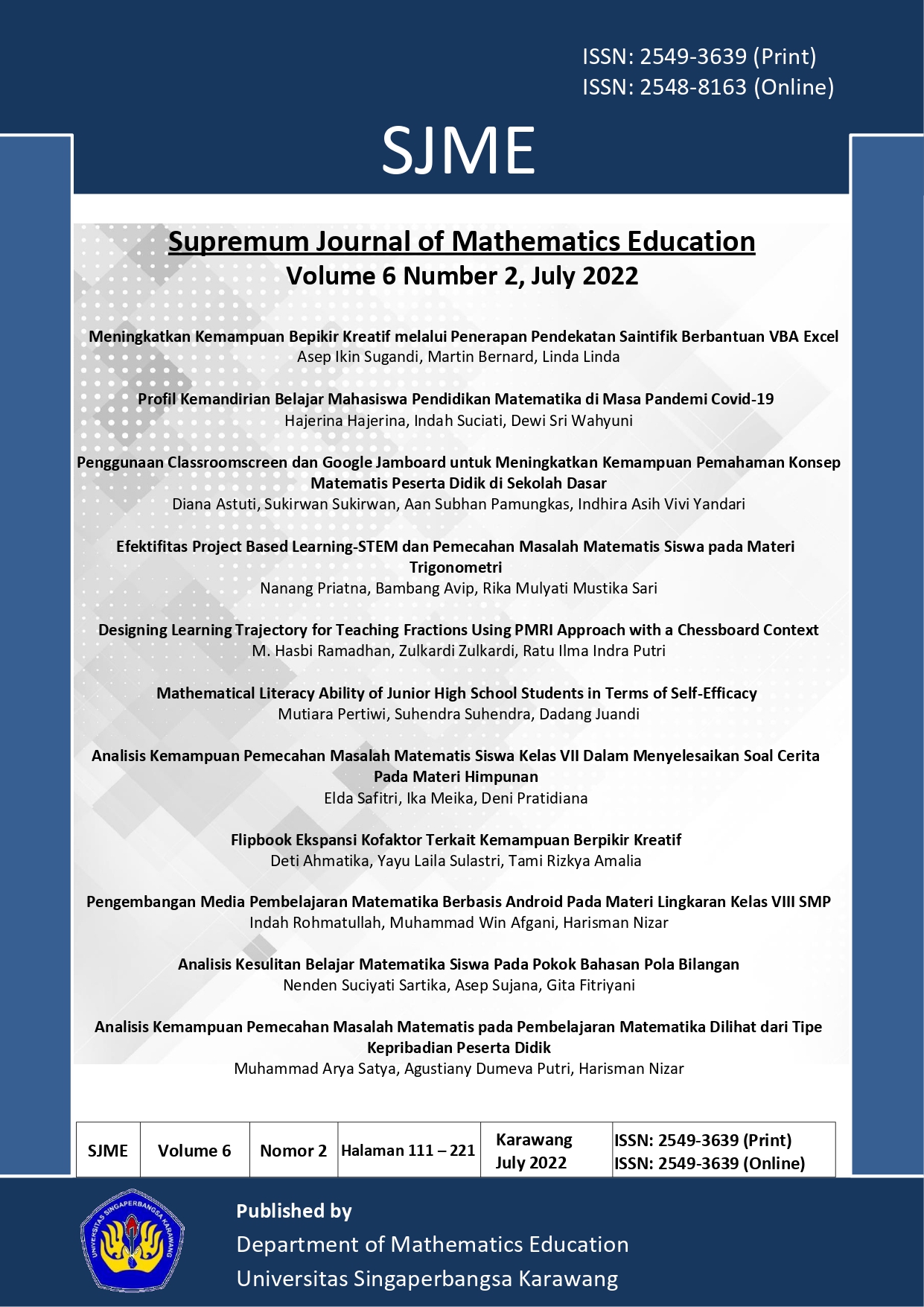Penggunaan Classroomscreen dan Google Jamboard untuk Meningkatkan Kemampuan Pemahaman Konsep Matematis Peserta Didik di Sekolah Dasar
DOI:
https://doi.org/10.35706/sjme.v6i2.6407Abstract
The purpose of this study is to find out the difference in the ability to understand mathematical concepts between students who use classroomscreen media and google jamboard media. The population in this study was a student of class V of SD Negeri Blok C Kota Cilegon Academic Year 2021/2022. The selection of samples by means of total sampling, obtained class V students consisting of V-A as a control class and V-B into an experimental class. The experimental class conducted learning with classroomscreen media, while the control class did learning with google jamboard media. Data retrieval is obtained by test methods to determine the ability to understand the mathematical concepts which are then analyzed with average difference tests. The result of the research obtained is the ability to understand the mathematical concepts of experimental class better than the ability to understand the mathematical concepts of control class.
Downloads
References
Burns, Amy M. (2020). Using technology with elementary music approach. New York: Oxford University Press.
Carsel, S. (2018). Metodologi Penelitian Kesehatan dan Pendidikan. Yogyakarta: Penyebar Media.
Direktorat Sekolah Dasar. (2022). Semua Wajib Melaksanakan PTM Terbatas pada 2022. Diakses tanggal 16 Maret 16 2022 dari ditpsd.kemdikbud.go.id.
Fauziah, I. B., Sukarno, S., & Sriyanto, M. I. (2020). Identifikasi kesulitan belajar matematika di rumah selama pandemi covid-19 pada siswa kelas IV Sekolah Dasar. Jurnal Pendidikan Dasar, 9(1), 25-30.
Hadisi, L., & Muna, W. (2015). Pengelolaan Teknologi Informasi dalam Menciptakan Model Inovasi Pembelajaran (E-Learning). Jurnal Al-Ta’dib, 8(1), 117–140.
Hasanah, E. (2019). Pengaruh Media Jamboard terhadap Motivasi Belajar dan Hasil Belajar Tajwid. Tesis Program Pascasarjana. Institut Ilmu Al-Quran Jakarta.
Jennah, R. (2009). Media Pembelajaran. Banjarmasin: Antasari Press.
Kartika, Y. (2018). Analisis Kemampuan Pemahaman Konsep Matematis Peserta Didik Kelas VII SMP Pada Materi Bentuk Aljabar. Jurnal Pendidikan Tambusai, 2(2), 777-785.
Mubarik dkk. (2019). Eksplorasi Proses Rekonstruksi Konsep Segiempat berdasarkan Kerangka Asimilasi dan Akomodasi. Prosiding Seminar Nasional Pendidikan Matematika II (SNPMAT II). Surabaya: Universitas Negeri Surabaya.
Rahmi, D.S. (2021). Analisis Kemampuan Pemahaman Konsep Matematis Siswa Selama Masa Covid-19 dalam Pembelajaran Daring Kelas VII SMP N 1 Tanjung Emas. Skripsi. Institut Agama Islam Negeri (IAIN) Batusangkar.
Rusmana, I.M., dan Idha S. (2012). Efektivitas Penggunaan Media ICT dalam Peningkatan Pemahaman Konsep Matematika. Jurnal Formatif, 2(3), 198-205.
Safitri, D., Riswan J., & Deskoni. 2015. Pengaruh Media Web Enhanced Course terhadap Hasil Belajar Peserta Didik pada Mata Pelajaran Ekonomi di MAN 1 Prabumulih. Jurnal Profit, 2(2), 152-158.
Sugiyono. (2017). Metode Penelitian Kuantitatif, Kualitatif, dan R&D. Bandung: Alfabeta.
Sulistyaningrum, R., Hidayati, Y.M., Sutama, S., & Desstya, A. (2021). Pemanfaatan Media Pear Deck dan Jamboard dalam Pembelajaran Matematika di Masa Pandemi Covid-19. Jurnal Basicedu, 5(5), 4169-4179.
Sumarmo, U., Hendriana, H., & Rohaeti, E. E. (2017). Hard Skills dan Soft Skills Matematik Siswa. Bandung: PT Refika Aditama.
Sweeney, E.M., Beger, A.W., & Reid.L. (2021). Google Jamboard for Virtual Anatomy Education. Clinical Teacher, 18(4), 341-347.
Tim KPAI. (2020). KPAI: Pembelajaran Jarak Jauh Minim Interaksi. Diakses tanggal 28 April 2021 dari kpai.go.id
Umaroh,U., & Pujiastuti, H. (2020). Analisis Kemampuan Representasi Matematis Siswa dalam Mengerjakan Soal PISA Ditinjau dari Perbedaan Gender. Jurnal Pendidikan Matematika Raflesia, 5(2), 40-53.
Yanti, R.A., Nindiasari, H., & Ihsanudin, I. (2020). Analisis Kemampuan Pemahaman Konsep Matematis Siswa SMP dengan Pembelajaran Daring. Wilangan: Jurnal Inovasi dan Riset Pendidikan Matematika, 1(3), 245-255.
Downloads
Published
How to Cite
Issue
Section
License

This work is licensed under a Creative Commons Attribution-ShareAlike 4.0 International License.
Authors who publish with this journal agree to the following terms:
- Authors retain copyright and grant the journal right of first publication with the work simultaneously licensed under a Creative Commons Attribution License that allows others to share the work with an acknowledgment of the work's authorship and initial publication in this journal.
- Authors are able to enter into separate, additional contractual arrangements for the non-exclusive distribution of the journal's published version of the work (e.g., post it to an institutional repository or publish it in a book), with an acknowledgment of its initial publication in this journal.
- Authors are permitted and encouraged to post their work online (e.g., in institutional repositories or on their website) prior to and during the submission process, as it can lead to productive exchanges, as well as earlier and greater citation of published work (See The Effect of Open Access).











